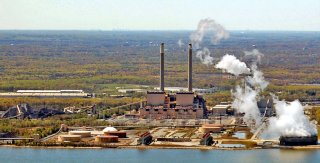Steam Electric Power Generating Effluent Guidelines - Deadline Extensions Rule

The EPA's Deadline Extensions Rule would extend compliance deadlines for coal-fired power plants in the Steam Electric Power Generating category (40 CFR Part 423).
On this page:
- Rule Summary
- Deadline Extensions Rule Public Webinars
- Deadline Extensions Rule Direct Final Rule Withdrawal
- Deadline Extensions Rule Documents
- Q&A
- Additional Information
Rule Summary
With this action, the EPA is proposing to extend compliance deadlines for the effluent limitations guidelines (ELGs) that apply to coal-fired power plants. This will allow facilities to respond to increases in demand and provide energy reliability for Americans. At the same time, the EPA will gather more information on implementation of the ELGs to evaluate feasibility and ensure a practical approach to protecting water resources while meeting critical energy demand.
Deadline Extensions Rule Public Webinars
The EPA hosted webinars for the public about the proposed rule and companion direct final rule on October 14, 2025 and November 12, 2025.
Deadline Extensions Rule Direct Final Rule Withdrawal
On November 25, 2025, due to adverse comment, EPA Administrator Lee Zeldin withdrew the direct final rule published on October 2, 2025. The Agency is developing a final rule informed by the comments on the proposed rule.
- Withdrawal of Direct Final Rule - Federal Register Notice (November 28, 2025)
Deadline Extensions Rule Documents
- Proposed Rule - Federal Register Notice
- Direct Final Rule - Federal Register Notice
- Fact Sheet (pdf)
- Support document:
Documents related to the rulemaking are available at regulations.gov. The Docket Number is EPA-HQ-OW-2009-0819.
Q&A
Why is the EPA taking this action?
This action advances the goals of President Trump’s Unleashing American Energy Executive Order by ensuring the country has reliable, affordable electricity while protecting our nation’s water resources under the Clean Water Act (CWA). A national energy crisis is impacting the U.S. electric power sector in the form of extraordinary increases in electricity demand driven in part by the artificial intelligence (AI) and datacenter revolution, as well as an industrial and manufacturing resurgence.
The existing compliance deadlines are simply unworkable in this dynamic reality and the EPA is taking action to relieve pressure on electricity producers and the grid. The Agency is committed to giving utilities more time to evaluate and plan for rapidly evolving electricity demand to ensure economic prosperity for the nation now and in the future and ensuring that reliable, high-performing, domestic sources of energy can continue to be counted upon.
Which provisions of the existing ELGs would change and which would not change?
This action would change compliance deadlines for the Steam Electric Power Generating category. It would also add new rule provisions that would allow permitting authorities flexibility to extend compliance deadlines on a site-specific basis due to unexpected electricity demand. While this action would not change the zero-discharge requirements themselves, the EPA is requesting information on technology-based implementation challenges related to the 2024 ELG rule to inform potential future rulemaking to support practical, feasible, on-the-ground implementation of wastewater pollution discharge limits.
How will this action impact the economy?
The EPA’s proposed rule would strengthen America’s position as the AI capital of the world while bolstering industrial competitiveness. At the same time, it prevents higher costs for local businesses, creating opportunities for new investments and growth. This means more money in the pockets of American families and more investment and growth opportunities for American businesses.
Will this action make electricity more affordable for Americans?
If finalized, this action would reduce costs for facilities and help with electricity reliability and affordability. The EPA’s current ELGs for wastewater discharges from steam electric power plants are potentially costly to an electric power sector that is struggling with increasing demand as AI is booming, data centers are being constructed and operated around the country, and American industry and manufacturing is resurgent. This action would give utilities more time to evaluate and plan for evolving energy demand for their customers/ratepayers.
Will this action make American electricity more reliable?
This action would keep existing steam electric power plants open and producing electric power, thereby making energy more reliable in America. This helps ensure adequate reserves of energy and reduces the risk of electricity blackouts.
How will this action impact the environment?
The EPA remains committed to ensuring that Americans have access to clean water. For more than 50 years, the EPA has partnered with States, Tribes, and stakeholders to implement the CWA and there have been significant reductions in pollution entering our Nation's waterways. Before the CWA, our surface waters suffered from pollution, with the Cuyahoga River becoming symbolic for catching fire at least a dozen times. Under the CWA, our Nation's waterbodies are now cleaner and safer and support recreation, wildlife, and economic opportunity. The Agency will continue to advance progress under the CWA, including by supporting practical and implementable standards for steam electric power plants.
What pollutants are found in wastewater from coal-fired power plants?
The ELGs for the Steam Electric Power Generating category apply to power plants that burn coal to create steam and generate electricity. These power plants use large volumes of water in their operation and maintenance. Their wastewater is treated before it is returned to the environment to reduce pollutants including selenium, mercury, arsenic, bromide, chloride, iodide, nitrogen, and phosphorus.
How will this action inform future rulemakings?
The EPA is requesting comment on real-world implementation challenges with the 2024 rule. The EPA will evaluate this on-the-ground information about implementation challenges of the 2024 rule to inform future action that could include rulemaking. Additionally, the Agency is seeking comment to ensure that rulemaking efforts incentivize continued coal-fired generation.
Additional Information
For additional technical information about the rule, please contact Richard Benware (benware.richard@epa.gov) or 202-566-1369. For economic information, please contact James Covington (covington.james@epa.gov) or 202-566-1034.
